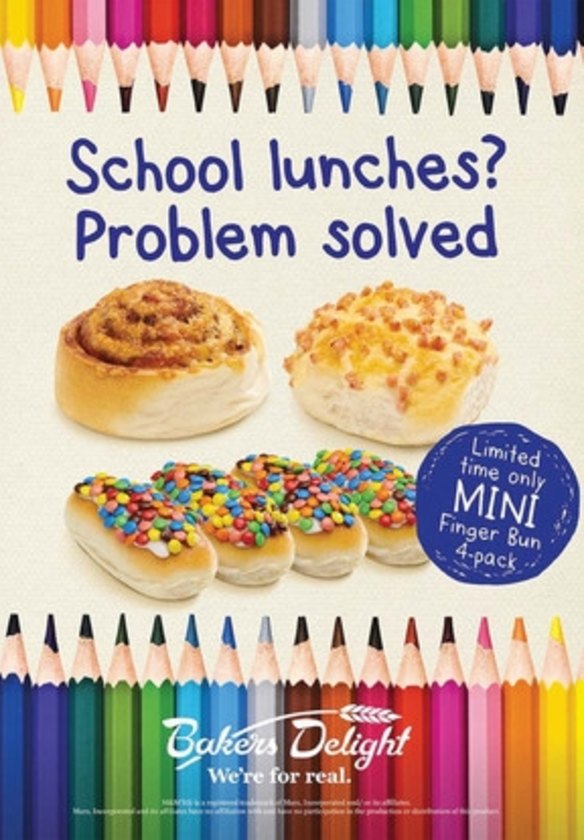School lunchboxes: why kids deserve better

For a dazzling example of the tug of war between food industry marketing and Australia's Dietary Guidelines, Bakers Delight's recent school lunch box suggestions are hard to beat.
"School lunches? Problem solved" is the cheery caption besides a picture of a white roll with bacon and cheese on top, a cheese and Vegemite scroll – and four white finger buns covered in M&Ms.
What were they thinking? Since when is a white bun sprinkled with M&Ms a great lunch box filler?

The cheese in the scroll and the bun might get points for calcium and protein, but can't we do better for a kid's lunch than white rolls with not much fibre? And bacon? That's a food the Cancer Council recommends eating less of.
The irony here is that Bakers Delight makes a great lunch box food: the Cape Seed Roll, rich in wholegrains and loaded with seeds and fibre (7.7.g of fibre per roll compared with 1.9g in the cheese and bacon roll). Why not promote these instead?
There's always the personal responsibility argument. Parents should know better. It's their job to ensure a kid's lunch box is packed with the right stuff. But why make it harder by pushing food for kids that are high in refined carbs and sugar?
"A survey of 'back to school' specials in Coles, Woolworths and Aldi catalogues by the Cancer Council Victoria and the Heart Foundation's Live Lighter campaign last month found that most of these foods were packaged and nutrient poor," says Alice Pryor, campaigns manager for Parents Voice, the online parent network that advocates for a healthier food and activity environment for children.
"We're constantly pushing against a tide of unhealthy food marketing – and at the same time there isn't enough promotion of what a healthy lunch box looks like," adds Jane Martin, executive manager of the Obesity Policy Coalition.
"People know fruit and vegetables are healthy, but they're not sure where other foods such as snack bars and bakery products fit. There should be a focus on the foods we need to eat less of as well as those we need to eat more of. We're losing sight of what healthy foods look like.
Knowing what's healthy is made harder by dishonesty in marketing – the front of pack wording that makes foods sound more nutritious than they really are.
You can't blame a parent for assuming that My Yummy lunch box Blackcurrant, Beetroot and Acai Cookies "with purple superfoods and ancient grains" are healthy. Yet when you check the ingredient list at the back of the pack it's not ancient grains and acai that are the top ingredients – it's wheat flour and castor sugar. Ingredient lists rank ingredients in descending order, meaning that the first ingredient contributes the most to the product and the last ingredient contributes the least. Acai ranks last on a list of 15 ingredients.
Meanwhile, the Healtheries brand of Kidscare snack products are marketed as "healthier lunch box snacks that your kids will love". But what's "healthier" about Kidscare Potato Stix, a food made with potato starch, rice, vegetable oil and vegetable powder with some additives and flavour thrown in – and what's it doing in the health food aisle?
But without tougher restrictions on the kind of foods marketed for kids and some rules around the use of words such as "healthy" on foods, it's hard to see anything changing. While food companies have to back up claims such as "low in salt" or "good source of fibre" under the Australian and New Zealand Food Standards Code, there's no rules around using "healthy", "natural" and "nutritious".
The Health Star Rating system for foods helps to a point in that it encourages manufacturers to improve ingredients in products in order to earn a higher star rating on the pack, says Ms Martin. An example is snack bars made with oats and 25 per cent less sugar recently added to the LCM range of children's snack bars which carries 3.5 stars.
Still, it's a small step not a giant leap forward – the other bars in the range have remained the same and are not a healthy snack, she points out.
But there's one promising move towards healthier lunch boxes – the Nude Food campaign – a movement that's growing among schools to encourage lunch box foods free of disposable packaging as a way of reducing waste, says Ms Pryor.
"Lunches will become healthier as a by-product of nude food – it's a way to encourage more whole food in the lunch box."
The best recipes from Australia's leading chefs straight to your inbox.
Sign up